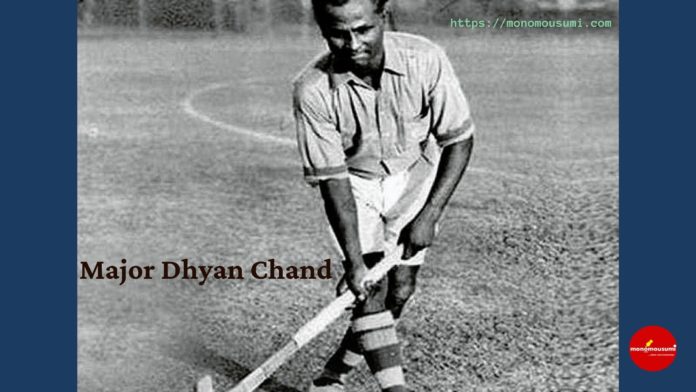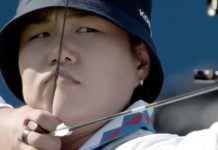The Indian men’s field hockey team finally ended the drought of 41 years since the Moscow Olympics,1980 by securing a bronze medal against Germany in Tokyo Olympics 2020 held on August 5, 2021. On the next day, the women’s hockey team also fought up to the last before losing its medal to Great Britain. The great performance of both the teams makes us go into the past and put some light on the life of our legendary hockey player, Major Dhyan Chand.
Dhyan Singh (childhood name of Dhyan Chand) was born on August 29, 1905, in the Prayagraj district of Uttar Pradesh (then known as Allahabad and was under the United Province). He could not complete his schooling because of the frequent transfers of his father who was working in the British Residency. He along with his family finally settled in the Jhansi district of the Bundelkhand region of Uttar Pradesh. Since his childhood, he had a great passion for hockey and used to play it in the moonlight. For the same reason, he got the title of ‘Chand’ which means ‘Moon’.
Dhyan Chand started his early career by working as a Sepoy in the British Indian Army in 1922. In 1926, he was selected in the Army hockey team of British India for a tour of New Zealand. The team played 21 matches out of which it won 18, drew 2, and lost only 1. This provided much fame to Dhyan Chand and his team. The main contribution of Dhyan Chand was in the Olympic games of 1928, 1932, and 1936. Each time the team won gold. In the 1936 Olympics, Dhyan Chand did the captaincy. During the final match against Germany held in Berlin, he even got one of his teeth broken by an opposite team player but it could not break the motivation of Dhyan Chand. He played barefooted and showed the power and spirit of the Indian team. Finally, India won it 8-1. After the defeat of Germany when Adolf Hitler offered him a higher post, he refused it. This shows his true patriotism for India. He is also known as ‘Hockey Wichard’ or the ‘Magician of Hockey’ due to his mastery of hockey.
He along with his team often faced a financial crunch and sometimes could not even afford 2 square meals a day but never lowered his morale. He played and won even when he had 103°F fever. Post-retirement, when a cameraman reached his home and requested a photo, he denied it because he was wearing torn clothes and did not want to discourage the hockey players that hockey did not provide enough earning even for the survival of a legendary player like him. He was very much concerned about the promotion of sporting culture in India and always wanted to improve it further.
In the Tokyo Olympics 2020, India showed her best performance so far by winning a total of 7 medals which include 1 Gold, 2 Silvers, and 4 Bronzes but this is far below the performance of the countries like China, United States, Japan, and Great Britain. At a time when we are about to celebrate the 75 years of our independence and aspiring for permanent membership in the United Nations Security Council (UNSC), we must make our sporting culture at par with that of 5 permanent members (i.e. United States, China, United Kingdom, France, and Russia).
To fulfill the dream of Major Dhyan Chand, the first step India needs to take is to make all the necessary structural changes associated with sports governance. These changes will start from the creation of the world-class sports infrastructure through more state funding followed by corporate funding. Schools should be promoted as the right places to shape a student into a gold medalist like Major Dhyan Chand. At the start, we need to set a feasible target of medals (e.g. total of 15 medals including 5 Golds) and gradually keep increasing this number. Starting should be done with those games in which we are already doing well and can do better such as field hockey, wrestling, badminton, tennis, shooting, archery, boxing, weightlifting, discus and javelin throw. The roles and responsibilities of all the stakeholders such as schools, village panchayats, sporting clubs, district administration, sports federations, sports authorities, and sports ministry should be aligned and all should work for a common goal. Playgrounds and multi-sports stadiums should be built at all levels i.e. village, town, and city-level so that regular practice and tournaments can be conducted. Being a diverse country, India has a lot of diverse talent. The people of each state have different strengths based on their genetic makeup and dietary habits. The promotion of One State One Sport can map this talent very well and create a series of medalists. The government needs to ensure that no sportsman faces a financial problem by rationalizing the prize distribution process so that all the players who missed the medal this time do not face any economic problems to prepare for a medal in the next Olympics. For example, if the government is providing an award of 50 lacs INR to a bronze medalist, it should also provide at least 25 lacs to a sportsman who failed to secure it. This will help and motivate them to perform better next time. We are already doing well in men’s cricket and need to follow the same for all other sports including women’s cricket by creating public interest in these sports. The corporates should also promote the other sportspersons apart from cricketers for the advertisement. This will solve the financial hardship of these players.
The decision of the government to celebrate the birthday of Major Dhyan Chand as the National Sports Day and the recent decision to rename the Rajiv Gandhi Khel Ratna to Major Dhyan Chandra Khel Ratna are great steps to remember his contribution to Indian sports. A good sporting environment will definitely produce more gold machines like him.
By Ravindra Kumar














